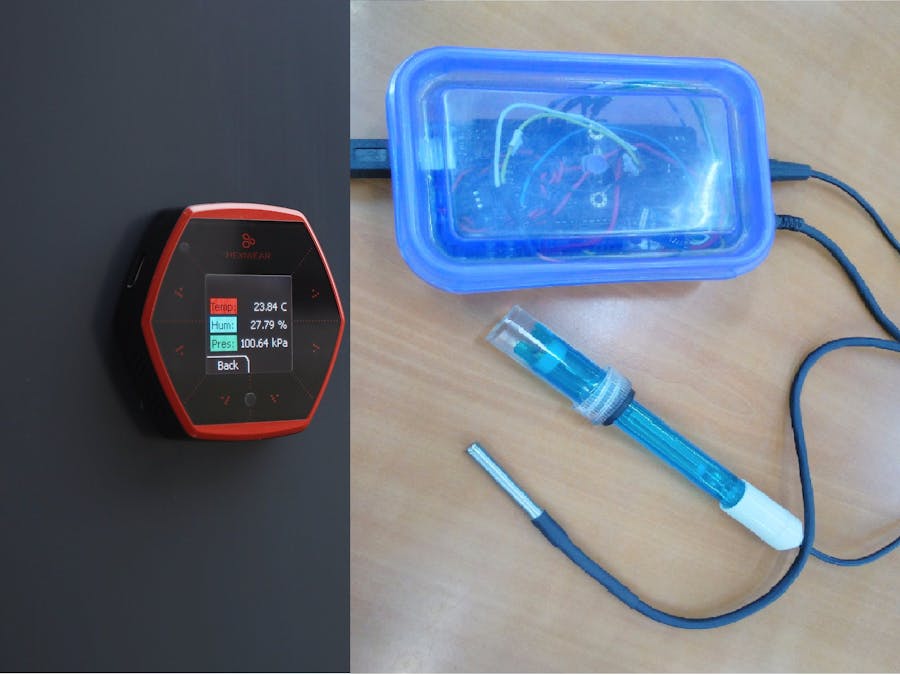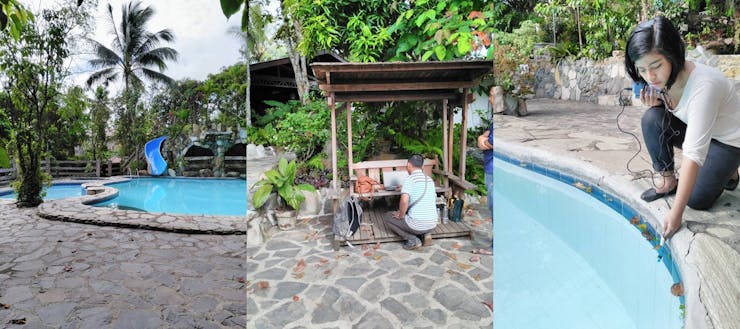Real-time water quality data monitoring and regulation adviser for swimming pools!

Things used in this project
Hardware components
Hand tools and fabrication machines
Soldering iron (generic)
Hot glue gun (generic)
Mini Plastic Container
Story
Objective
The primary objective of this project is to use Hexiwear to monitor the pH and temperature levels of swimming pools.
Hexiwear Setup
The Hexiwear can be placed anywhere near the bluetooth range of the Hardware Sensor. Using the LCD screen, it displays the Temp and pH Sensor.
The Hexiware can be programmed to analyze the data from sensors given the computation of Langelier Saturation Index (LSI). Using the LSI we can calculate if the pool is acidic, alkaline or in normal level. The computation can also give recommendations on how many chemicals to be put on the water to stabilize the level.
Hardware Sensor Setup
The hardware station prototype is placed inside a 4.3” x 1.9” rectangular plastic container and was created by connecting an Arduino Uno R3 to a pH sensor, temperature sensor, and Bluetooh Module. The power source is connected through a USB cable and power bank.
Field Test
We have tested the hardware sensor to Private, Public and School Swimming Pool. Collecting the data from these respondents' pool enabled us to analyze the capability of the hardware.
Public Pool

Photos from a Public Resort.
Private Pool

Photos from a Rest House Swimming pool.
School Pool

Photos from a private school swimming pool.
Results
We wanted to provide an automated swimming pool water quality monitoring.
The development is still in progress. But we hope that through this, may there will be an increased awareness regarding the continuous degradation of the swimming pool water quality as people tend to focus more on the amenities that are offered instead of checking how safe they are. They also intend to contribute to the community by being able to provide a means to make water quality testing more efficient and effective without the unnecessary sacrifice of resources.
Schematics
Arduino Circuit Diagram
Connect the sensors and bluetooth module using jumper wires to the Arduino Uno.
Bluetooth module to RX/TX
Temp Sensor Output(Blue) to Analog 0, GND(Black) to GND and V(Red) to 5V.
pH Sensor Output to Analog 1(Green), GND(Black) to GND and V(Red) to 5V.

Code
Arduino Code
C/C++
This is the code programmed to the Arduino Uno. Once loaded, the Arduino will continuously monitor the Temp and pH Sensor output and sends it to the Bluetooth serial.
#include <SoftwareSerial.h>
#include <OneWire.h>
#include <DallasTemperature.h>
#define SensorPin A0 //pH meter Analog output to Arduino Analog Input 0
#define Offset 0.00 //deviation compensate
#define LED 13
#define samplingInterval 20
#define printInterval 800
#define ArrayLenth 40 //times of collection
int pHArray[ArrayLenth]; //Store the average value of the sensor feedback
int pHArrayIndex=0;
#define tempOffSet 0.00
#define DEBUG false
#define responseTime 20
#define ONE_WIRE_BUS 4 // Data wire is plugged into port 2 on the Arduino
OneWire oneWire(ONE_WIRE_BUS); // Setup a oneWire instance to communicate with any OneWire
//devices (not just Maxim/Dallas temperature ICs)
DallasTemperature sensors(&oneWire); // Pass our oneWire reference to Dallas Temperature.
SoftwareSerial bluetoothSerial(2, 3); // RX, TX
void setup()
{
//setup RGB LED as indicator instead of softserial
pinMode(12,OUTPUT);
digitalWrite(12,HIGH);
// Open serial communications and wait for port to open:
Serial.begin(115200);
while (!Serial) {
; // wait for serial port to connect. Needed for Leonardo only
}
bluetoothSerial.begin(115200);
while (!bluetoothSerial) {
; // wait for serial port to connect. Needed for Leonardo only
}
sendTobluetooth("AT+CWMODE=2",responseTime,DEBUG); // configure as access point
sendTobluetooth("AT+CIFSR",responseTime,DEBUG); // get ip address
sendTobluetooth("AT+CIPMUX=1",responseTime,DEBUG); // configure for multiple connections
sendTobluetooth("AT+CIPSERVER=1,80",responseTime,DEBUG); // turn on server on port 80
sendToUno("Safepools.pH Hardware is ready!",responseTime,DEBUG);
}
void loop()
{
///// Read pH Regularly //////
static unsigned long samplingTime = millis();
static unsigned long printTime = millis();
static float pHValue,voltage;
if(millis()-samplingTime > samplingInterval)
{
pHArray[pHArrayIndex++]=analogRead(SensorPin);
if(pHArrayIndex==ArrayLenth)pHArrayIndex=0;
voltage = avergearray(pHArray, ArrayLenth)*5.0/1024;
pHValue = 3.5*voltage+Offset;
samplingTime=millis();
}
if(Serial.available()>0){
String message = readSerialMessage();
if(find(message,"debugdebugBluetooth:")){
String result = sendTobluetooth(message.substring(13,message.length()),responseTime,DEBUG);
if(find(result,"OK"))
sendData("\nOK");
else
sendData("\nEr");
}
}
if(bluetoothSerial.available()>0){
String message = readbluetoothSerialMessage();
if(find(message,"debugBluetooth:")){
String result = sendTobluetooth(message.substring(8,message.length()),responseTime,DEBUG);
if(find(result,"OK"))
sendData("\n"+result);
else
sendData("\nATCE1001"); //At command ERROR CODE for Failed Executing statement
}else
if(find(message,"getT")){
float temp = 0;
sensors.requestTemperatures(); // Send the command to get temperatures
temp = sensors.getTempCByIndex(0);
sensors.requestTemperatures(); // Send the command to get temperatures
temp = sensors.getTempCByIndex(0);
if(temp==85)
sendData("\nTE1001"); //Temperature ERROR CODE for INITIALIZE
else if(temp==0 || temp==-127)
sendData("\nTE1002"); //Temperature ERROR CODE for NOT CONNECTED
else{
String temperature = "";
temperature+=temp+tempOffSet;
sendData("\n"+temperature);
}
}else
if(find(message,"getP")){
//sending ph level:
if(pHValue==0){
sendData("\nPE1001"); //pH ERROR CODE for NOT OPEN
}else{
String ph = "";
ph+=pHValue;
sendData("\n"+ph);
}
}else if(find(message,"pHOff")){
//sending ph level:
digitalWrite(12,0);
}else if(find(message,"pHOn")){
//sending ph level:
digitalWrite(12,1);
}
else{
sendData("\nErrRead"); //Command ERROR CODE for UNABLE TO READ
}
}
delay(responseTime);
}
double avergearray(int* arr, int number){
int i;
int max,min;
double avg;
long amount=0;
if(number<=0){
Serial.println("Error number for the array to avraging!/n");
return 0;
}
if(number<5){ //less than 5, calculated directly statistics
for(i=0;i<number;i++){
amount+=arr[i];
}
avg = amount/number;
return avg;
}else{
if(arr[0]<arr[1]){
min = arr[0];max=arr[1];
}
else{
min=arr[1];max=arr[0];
}
for(i=2;i<number;i++){
if(arr[i]<min){
amount+=min; //arr<min
min=arr[i];
}else {
if(arr[i]>max){
amount+=max; //arr>max
max=arr[i];
}else{
amount+=arr[i]; //min<=arr<=max
}
}//if
}//for
avg = (double)amount/(number-2);
}//if
return avg;
}
/*
* Name: sendData
* Description: Function used to send string to tcp client using cipsend
* Params:
* Returns: void
*/
void sendData(String str){
String len="";
len+=str.length();
sendTobluetooth("AT+CIPSEND=0,"+len,responseTime,DEBUG);
delay(100);
sendTobluetooth(str,responseTime,DEBUG);
delay(100);
sendTobluetooth("AT+CIPCLOSE=5",responseTime,DEBUG);
}
/*
* Name: find
* Description: Function used to match two string
* Params:
* Returns: true if match else false
*/
boolean find(String string, String value){
if(string.indexOf(value)>=0)
return true;
return false;
}
/*
* Name: readSerialMessage
* Description: Function used to read data from Arduino Serial.
* Params:
* Returns: The response from the Arduino (if there is a reponse)
*/
String readSerialMessage(){
char value[100];
int index_count =0;
while(Serial.available()>0){
value[index_count]=Serial.read();
index_count++;
value[index_count] = '\0'; // Null terminate the string
}
String str(value);
str.trim();
return str;
}
/*
* Name: readbluetoothSerialMessage
* Description: Function used to read data from debugBluetooth Serial.
* Params:
* Returns: The response from the debugBluetooth (if there is a reponse)
*/
String readbluetoothSerialMessage(){
char value[100];
int index_count =0;
while(bluetoothSerial.available()>0){
value[index_count]=bluetoothSerial.read();
index_count++;
value[index_count] = '\0'; // Null terminate the string
}
String str(value);
str.trim();
return str;
}
/*
* Name: sendTobluetooth
* Description: Function used to send data to debugBluetooth.
* Params: command - the data/command to send; timeout - the time to wait for a response; debug - print to Serial window?(true = yes, false = no)
* Returns: The response from the debugBluetooth (if there is a reponse)
*/
String sendTobluetooth(String command, const int timeout, boolean debug){
String response = "";
bluetoothSerial.println(command); // send the read character to the debugBluetooth
long int time = millis();
while( (time+timeout) > millis())
{
while(bluetoothSerial.available())
{
// The esp has data so display its output to the serial window
char c = bluetoothSerial.read(); // read the next character.
response+=c;
}
}
if(debug)
{
Serial.println(response);
}
return response;
}
/*
* Name: sendTobluetooth
* Description: Function used to send data to debugBluetooth.
* Params: command - the data/command to send; timeout - the time to wait for a response; debug - print to Serial window?(true = yes, false = no)
* Returns: The response from the debugBluetooth (if there is a reponse)
*/
String sendToUno(String command, const int timeout, boolean debug){
String response = "";
Serial.println(command); // send the read character to the debugBluetooth
long int time = millis();
while( (time+timeout) > millis())
{
while(Serial.available())
{
// The esp has data so display its output to the serial window
char c = Serial.read(); // read the next character.
response+=c;
}
}
if(debug)
{
Serial.println(response);
}
return response;
}The article was first published in hackster, September 1, 2016
cr: https://www.hackster.io/safepools-ph/safepools-ph-408029
author: Team Safepools.pH: Jeff-Paredes, Alysson Alvaran











